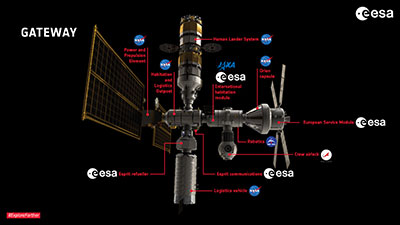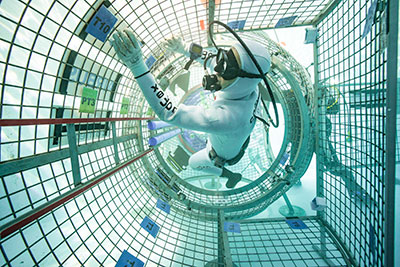NASA, European Space Agency Formalize Artemis Gateway PartnershipNASA and ESA (European Space Agency) have finalized an agreement to collaborate on the Artemis Gateway. This agreement is an important element in a broad effort by the United States to engage international partners in sustainable lunar exploration and to demonstrate technologies necessary for a future human mission to Mars. The agreement, signed Tuesday (Oct. 27), marks NASA's first formal commitment to launch international crew members to the lunar vicinity as part of NASA's Artemis missions.
The agreement is a critical part of NASA's efforts to lead an unprecedented global coalition to the Moon. Additional Gateway agreements with other international partners will be executed in the near future, further contributing to the creation of a dynamic and sustainable lunar exploration architecture.
Under this agreement, ESA will contribute habitation and refueling modules, along with enhanced lunar communications, to the Gateway. The refueling module also will include crew observation windows. In addition to providing the hardware, ESA will be responsible for operations of the Gateway elements it provides. ESA also provides two additional European Service Modules (ESMs) for NASA's Orion spacecraft. These ESMs will propel and power Orion in space on future Artemis missions and provide air and water for its crew.
"This partnership leverages the outstanding cooperation established by the International Space Station as we push forward to the Moon," said NASA Administrator Jim Bridenstine. "Gateway will continue to expand NASA's cooperation with international partners like ESA, ensuring the Artemis program results in the safe and sustainable exploration of the Moon after the initial human lunar landing and beyond."
The International Habitation module (I-Hab) includes components Japan intends to contribute and two docking ports where human landing systems can aggregate. The habitation module also will house the outpost's Environmental Control and Life Support System (ECLSS), contain accommodations for internal and external science experiments, and provide additional crew work and living space. I-Hab's ECLSS will augment Gateway's life support system capabilities provided by the docked Orion, enabling longer durations at the Gateway and support more robust Artemis missions to the lunar surface.
"The Gateway is designed to be supplemented by additional capabilities provided by our international partners to support sustainable exploration," said Kathy Lueders, NASA associate administrator for the Human Exploration and Operations Mission Directorate at NASA Headquarters. "Gateway is going to give us access to explore more of the lunar surface than ever before and we're pleased that partners like ESA will join us on these groundbreaking efforts."
The Gateway will be assembled in orbit around the Moon as a staging point and enabling platform for missions to the lunar surface, Mars, and other deep space destinations. Approximately one-sixth the size of the International Space Station, the Gateway will function as a way station located tens of thousands of miles from the lunar surface, in a Near Rectilinear Halo Orbit, from which NASA and its international and commercial partners will be able to springboard robotic and human expeditions to and around the Moon and on to Mars. It will serve as a rendezvous point for astronauts traveling to lunar orbit aboard NASA's Space Launch System (SLS) and Orion prior to transit to low-lunar orbit and the surface of the Moon.
"Gateway is the physical manifestation of the international and commercial partnerships that will be the hallmark of the Artemis era of exploration," said Mike Gold, NASA acting associate administrator for the Office of International and Interagency Relations at NASA Headquarters. "Artemis will harness the largest and most diverse human space exploration coalition in history, and the signing of this MOU is the first step in what will be a historic journey of discovery."
Along with procuring commercial services to deliver NASA astronauts to the final leg of the journey to the lunar surface, NASA has contracted with U.S. industry to develop the first two Gateway components, the integrated Power and Propulsion Element and the Habitation and Logistics Outpost, as well as the logistics resupply for Gateway.
In March, the first two scientific investigations to fly aboard the Gateway were selected, one from NASA and the other from ESA. ESA developed the European Radiation Sensors Array, or ERSA, and NASA's Goddard Space Flight Center is building the Heliophysics Environmental and Radiation Measurement Experiment Suite, or HERMES. The two mini weather stations will split up the work, with ERSA monitoring space radiation at higher energies with a focus on astronaut protection, while HERMES monitors lower energies critical to scientific investigations of the Sun.
All of Gateway's international partners will collaborate to share the scientific data that will be transmitted to Earth. Additional scientific cooperative payloads will be selected to fly aboard the Gateway in the future.
"Science will play a critical role in the Artemis program," said Thomas Zurbuchen, associate administrator for the Science Mission Directorate at NASA Headquarters in Washington. "Between NASA's HERMES and ESA's ERSA, these and future payloads on the Gateway will help us learn more about space weather and protecting astronauts even as our work to land commercial payloads on the Moon helps advance lunar science and human exploration on the surface of the Moon."
In addition to supporting lunar surface missions, the Gateway will support activities that will test technologies needed for human missions to Mars. Using the Gateway, NASA will demonstrate remote management and long-term reliability of autonomous spacecraft systems and other technologies.
"The Gateway will enable sustained Artemis operations while also serving as a catalyst for research and demonstrating new technologies, taking advantage of the unique environment in lunar orbit," said Dan Hartman, Gateway program manager at NASA's Johnson Space Center in Houston. "ESA's impactful contribution will enable longer crew duration stays around the Moon and provide unique capabilities necessary to support its operations."













